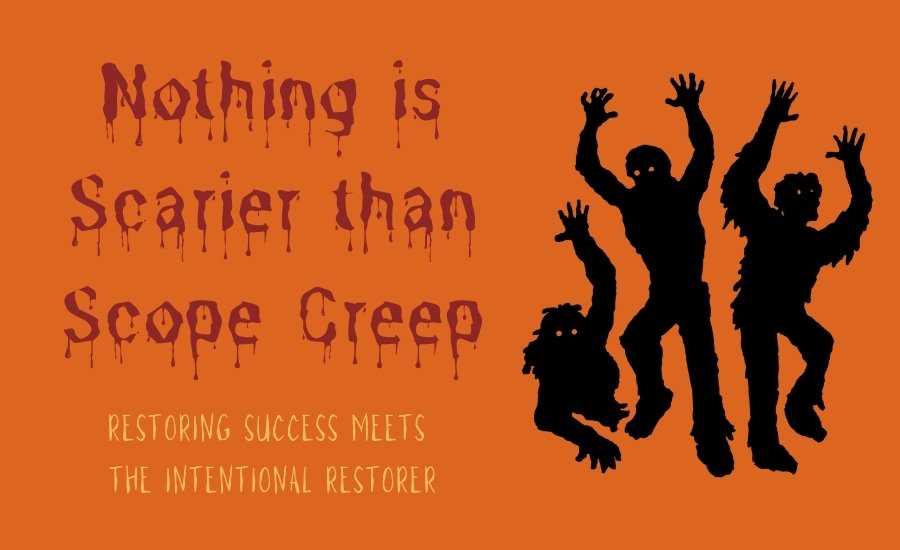I have three simple golden rules with a fourth to beware of that apply to the profitable execution of a scope of work.
- Get paid for what you do
- Do not pay more than you get paid
- Subcontractors
- Materials
- Manage your in-house manhours
- Mistakes happen and cost money; they must be managed to keep to a minimum. Learn from mistakes and have a spirit of continuous improvement.
If we start with the premise of a job with a thorough and accurate scope of work, we now must execute it to company standards and objectives that may include quality, service, and profitability. The golden rules seem simple and like common sense; however, in my experience, it is the breaking of these rules that often result in missing the mark on profitability objectives.
Scope creep occurs in many facets and a variety of circumstances in our companies. In simple terms, it is when we deviate from the scope of work and fail to account for it in the revenues. It breaks the golden rules #1 and #2. The scope is typically the basis for a bill or estimate that represents the company’s revenues. When we go outside the bounds of the scope without accounting for it, the operating results on the bottom line, can be quite frightening.
Scenarios
(Technician Level) Last Day of Water Mitigation: A technician is sent to pull the equipment, clean the living room carpet, and get a COS (Certificate of Satisfaction) signed.
Homeowner: “While you are here, can you go ahead and clean the dining room carpet?”
Technician wants to please the very nice homeowner: “Sure, it would be my pleasure.” And so our well-intentioned technician cleans the carpet in the extra room, notices a red stain, goes to the truck for the spotting kit, proceeds to work on the stain and….
SCOPE CREEP is discovered when the job is two hours over in labor hours and the project misses the profitability target, or worse, that free service morphs into a nightmare.
(Estimator Level) Remove and Reset a Bathroom Vanity: Homeowner decides they want a new vanity. The estimator/project manager is amicable as it does not seem that it will be any trouble to install the 36-inch-wide vanity that the homeowner will supply.
Last day of job: Upon unwrapping the vanity, there is damage found to the cabinet. The homeowner asks the carpenter to just go get a new one in stock at the ABC Store. The carpenter goes and they are out of stock; the carpenter now must now schedule another day for pick up and to complete the tasks. This project is now all tricks and no treats and it gets worse when we discover the new cabinet is two inches taller than the old cabinet. Now, the mirror needs to be raised, the plumbing needs to be adjusted and…
SCOPE CREEP is discovered when this relatively small job is 10 labor hours over and has missed the profitability mark in addition to the customer experience turning into a horror saga.
(Executive Level) A Favor for A Friend: The owner or general manager calls all the staff to the conference room to make a special announcement, a good friend of theirs needs something done ASAP.
When an owner, or a member of the people in a position of leadership team, brings in a project that is personal to them and wants the assignment bumped to the top of the list (regardless of what is going on) as a favor to a friend to make themselves look good, this sends a mixed message to the team. If you spend any amount of time trying to build a culture and a process that optimizes your ability to do things the right way, efficiently and with a touch of excellence, these “favors” demonstrate that there are exceptions to your values.
This favor for a friend is light on details and heavily loaded with unclear expectations. Because the normal processes have been overridden, the project is doomed to result in frustration for all parties involved.
SCOPE CREEP is discovered usually at the end of the project when the customer is unhappy, the production team is frustrated, and the owner is ready to howl at the moon. We can’t even talk about profit as there is none; this is a toxic dump of wasted energies. These projects are doomed from the beginning when they are set up as:
- Scope = “Get it done.”
- Budget/Price = “They’re good for it.”
- Timeline = “Yesterday.”
The lack of an accurate and thorough scope of work and no expectations communicated to the team and customer has set the execution of the job to have the creepiest of outcomes.
Reasons Why this Happens
Emotional Discounting: A friend of mine recently exposed me to this term and concept and I thought, YES! We do this often from doing little extra things without charging to rendering services free of charge. This article, How to Stop Offering ‘Emotional’ Discounts, explains it well and offers some tips on how to stop or control the phenomenon.
Not understanding the scope: If those who are charged with executing the scope are not trained to understand it, scope creep is inevitable. Within most of the estimating systems used in our industry, a line item includes a very specific amount or type of activity, labor, and materials. If those executing the scope do not understand it, it will be challenging or impossible to manage it to budget and/or know when to communicate/address deviations in the scope through your company process (i.e. supplements and/or change orders).
How do we train and empower our team to prevent scope creep?
In the carpet cleaning scenario above, it’s important to understand the motivation. The technician wants to do a good job, they want to please the customer, and they should be empowered to find ways to make this happen. I try to train our teams with the mindset of:
- Do It Right
- Do It Efficiently
- Do It Excellently
While well-intentioned, what are a few of the things that could make this carpet cleaning and red stain removal scenario into a Nightmare on Elm Street? Have you heard the saying, “No good deed goes unpunished?” Whether we are doing scope work, change orders, or complimentary add on, we need to document our scope, clarify the expectations, and track the cost (even if it is a no charge). Within the organization, clear protocols on any deviations of scope and/or supplements need to exist and be clearly communicated to team members.
Small favors like carpet cleaning could lead to our team owning a carpet that we cleaned as a gesture of good faith. That tiny red stain could become the Creature from the Loom Lagoon, leading to a spread of toxic ooze. Additionally, those two unaccounted for hours could set the technician back from their next project and the accumulation of upset customers grows into a horde of Zombies who want to eat our flesh.
One suggestion would be to bake in the carpet cleaning after a mitigation or repair project as a satisfaction add. The book Be Intentional: Estimating outlines the importance of developing a consistent estimating process to produce better insurance claims outcomes. Empower technicians to understand:
- The law of unintended consequences, not making them cynics but considering the big picture.
- Understanding that even if we do something for “free” we need to document, get authorization of the agreed scope/outcome.
- Communicate with the whole team so the impact to the schedule can be accounted for.
How to Minimize SCOPE CREEP
Training and education will help minimize scope creep. From understanding scopes to company-specific processes, training should be position-appropriate and timely to the individual’s ability to contribute to the successful execution of scopes. Some team members may be responsible to execute a work order or specific instructions and not necessarily follow a complex scope, following instructions is a skill that should be deliberately developed in team members and will help control scope creep that occurs when instructions are disregarded or not followed. Scary things happen when, People Don’t follow Instructions.
Metrics and Review Systems are important to be able to proactively manage scope creep and develop the team’s abilities. Red Flags can help you identify a job that may be going in the wrong direction, identify team members that may need training, and/or identify weaknesses in company systems.
Empowerment and trust in the team will help engage them in keeping scope creep under control. Empowerment includes giving appropriate authority to execute or manage deviations from scope. For example, different positions may have different levels of authority to fully execute a change order. Give the appropriate tools and resources and the ability to use discretion and exercise good judgment when appropriate.
Don’t be scared of scope creep; manage it proactively as a team. Although it is in our nature as restorers to go above and beyond to help those we serve through a difficult time, margins are thin and overhead continues to grow. We cannot afford excessive scope creep even when it is well=intentioned.
Thank you to Jon Isaacson, The DYOJO Podcast for collaborating on this edition. Some bonus thoughts and tips from Jon to help us enjoy Restoring Success…
Those in a position of leadership must lead by example or there is no standard.
In the scenarios involving estimators and owners above, the issue is with lack of clarity on the scope, expectations, cost, and duration of the project. While emergency response is inherent to our work, chaos should not be accepted and The DYOJO shares ways in which an organization can reduce dysfunction in their video on this topic.
When a client makes a “small request” for an alteration to their project, they often honestly have no frame of reference for how this new scope affects the existing production plan. Unfortunately, many estimators and managers don’t understand these impacts either.
In his book, Joy, Inc., Richard Sheridan shares a simple process that his software design team uses for project management. I was surprised in reading the book how many parallels there were between scope creep in these two disparate industries. To ensure that clients, team members, and the organization are on the same page, the aspects of the work are assembled on index cards. An index card associates scope with time budgeted to complete the task.
The design team regularly meets with the client. In these meetings, if a client wants to make a change without affecting the duration or cost, they must pull index cards from the project board. There has to be an equal reduction of scope/cost/duration to account for new items. This is a simplified account of the process but there is nothing better than making it visible and helping all parties to see the impacts of “just a little change.”
- Doing it right as a company includes ensuring the client, carrier and your production team are clear on what the scope of work is as well as what it isn’t.
- Doing it efficiently as an organization means that all parties in the process are engaged in being able to read the scope, execute the scope and communicate when there are legitimate deviations.
- Doing it excellently as a team requires everyone to be trained to read a scope clearly, communicate consistently and hold each other accountable to doing the right thing the right way.
 As a restoration company owner, you don’t need to add another piece of equipment or tool to your belt unless it is going to keep you from having to do MORE work. When business owners learn of yet another piece of technology or software that is supposed to help their company grow and be more productive, it isn’t shocking when they are reluctant or hesitant to try it. While there are many types of software and apps and programs that really don’t provide enough for business owners to benefit from using them, iRestore’s restoration management software is not one of them.
As a restoration company owner, you don’t need to add another piece of equipment or tool to your belt unless it is going to keep you from having to do MORE work. When business owners learn of yet another piece of technology or software that is supposed to help their company grow and be more productive, it isn’t shocking when they are reluctant or hesitant to try it. While there are many types of software and apps and programs that really don’t provide enough for business owners to benefit from using them, iRestore’s restoration management software is not one of them. As children are learning to speak and communicate, we often say, “use your words.” An important soft skill that, as adults and restoration professionals, we should never stop developing in ourselves and others. The following excerpt is a brief description from childcare.net as to the importance of developing this skill:
As children are learning to speak and communicate, we often say, “use your words.” An important soft skill that, as adults and restoration professionals, we should never stop developing in ourselves and others. The following excerpt is a brief description from childcare.net as to the importance of developing this skill:









